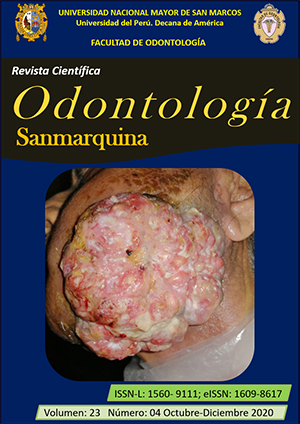Carrea's method usefulness to estimate a peruvian population actual stature
DOI:
https://doi.org/10.15381/os.v23i4.17791Keywords:
Forensic dentistry, Anthropometry, Body height, (Source: MeSH NLM)Abstract
Objective. To determine the usefulness of Carrea’s method for estimating the stature. Methods. This is a quantitative observational and cross-sectional design study. The used sample was of 188 students (84 women, 104 men) 21.07 year old average and their respective plaster models. The actual stature and estimated stature for each student was determined by means of the height rod and the Carrea’s method respectively to establish the absolute difference between them and to determine - by means of the Student's t test for independent samples - if this difference was significant. The intraclass correlation coefficient was used to determine the concordance strength between the actual and estimated stature. Results. The difference between actual stature average and estimated one was 4.4 centimeters. The absolute average difference between them was 6.9 centimeters. These differences were significant to Student's t test for independent samples. The concordance strength between the real and estimated stature was 0.791 (ICC=0.791), which allowed us to categorize this concordance as good. Conclusions. Carrea's method is useful in stature estimation. Its limitations in terms of accuracy must be taken into consideration before reaching a conclusion, especially if the individuals analyzed are related to forensic contexts in which identification plays a relevant role in the legal and humanitarian field.
Downloads
Downloads
Published
Issue
Section
License
Copyright (c) 2020 Marcia Alejandra Moreno-Sánchez, Hugo Humberto Caballero-Cornejo, Carlos Alberto Suárez-Canlla

This work is licensed under a Creative Commons Attribution-NonCommercial-ShareAlike 4.0 International License.
AUTHORS RETAIN THEIR RIGHTS:
a. Authors retain their trade mark rights and patent, and also on any process or procedure described in the article.
b. Authors retain their right to share, copy, distribute, perform and publicly communicate their article (eg, to place their article in an institutional repository or publish it in a book), with an acknowledgment of its initial publication in the Odontología Sanmarquina.
c. Authors retain theirs right to make a subsequent publication of their work, to use the article or any part thereof (eg a compilation of his papers, lecture notes, thesis, or a book), always indicating the source of publication (the originator of the work, journal, volume, number and date).






